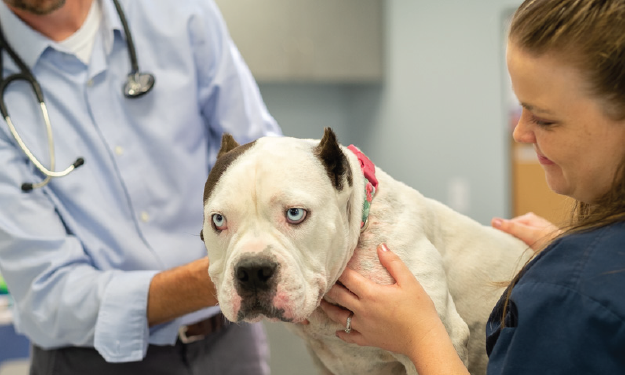Osteosarcoma in Dogs

What is Osteosarcoma?
Osteosarcoma is the most common primary bone tumor seen in dogs. This is in essence a cancer the develops from the cells that make up the bone. The most common sites in which this tumor occurs are the long bones in the front and hind legs. Osteosarcoma can occur in the flat bones such as the skull, spine, and pelvis, but this is much less common. Though osteosarcoma can happen to a dog of any age, it usually affects large breed dogs that are middle-aged to older. The more common breeds affected are Saint Bernard’s, Great Danes, Irish Setters, Dobermans, German Shepherds, Golden Retrievers, Irish Wolfhounds, and Rottweilers.
What are the Signs of Osteosarcoma?
The most common sign that dogs show when osteosarcoma is diagnosed is pain or swelling in one of the long bones of the body. This is typically in the front or hind legs. It is common for these signs to have been present for weeks or months in advance of a diagnosis. This discomfort will often respond for short periods of time to commonly used anti-inflammatory drugs. As the tumor grows, the affected area will continue to swell and weaken. In some cases, sudden signs of lameness can occur after the weakened bone fractures. This is referred to as a pathologic fracture.
Is the Tumor in the Leg the Most Important Part of Osteosarcoma?
Although pain and discomfort associated with the primary tumor is an important problem for dogs with this disease, it is important to understand that this is a cancer that is highly metastatic, and as such spreads to other parts of the body quickly (most commonly the lungs). Ninety (90%) percent of dogs have had microscopic spread of this disease at the time that their primary tumor is diagnosed.
How is Osteosarcoma Diagnosed?
The development of pain and swelling in a long bone of an older dog, particularly in an at-risk breed, should prompt consideration of osteosarcoma as a diagnosis. X-rays of the affected limb can strongly support a diagnosis. Bone biopsies are generally needed to obtain a definitive diagnosis, but if the radiographs are strongly suspicious in an older large breed dog, a biopsy is often not needed.
What Additional Diagnostic Tests are Needed?
Following a biopsy or radiographic diagnosis of osteosarcoma, chest x-rays are necessary to determine if there is evidence of metastasis to the lungs. Blood work consisting of a CBC to assess the red and white blood cells and platelets, and a chemistry panel to look at organ function and a urinalysis are recommended.
What are the Initial Treatment Options for Osteosarcoma?
Treatment options vary; however, the most effective treatment combines therapy for both the primary tumor and to lessen the risk of disease spread (metastasis). Surgery is the most common and effective treatment of the primary tumor. The most common surgery is an amputation of the affected limb. Most pets, even the largest of breeds, do very well following an amputation and are up and walking 36 hours after surgery. Radiographs of the other limbs should be taken prior to amputation to determine if your pet will be able to ambulate well on 3 limbs. An alternative to amputation is a surgery called limb-square and is available only if the tumors are in specific locations (distal aspect of the front limb). This is a complicated surgery and is only performed at select veterinary surgery centers that can remove the tumor without including amputation. Complications include infection, implantation rejection, fracture, and the possibility of tumor recurrence at the site. Another surgical treatment is stereotactic radiosurgery. In this type of treatment, high doses of radiation are delivered while in surgery with the hopes of destroying the cancerous portion of the limb. The benefit of this surgery is that no significant functional impairment of the limb is anticipated and recovery long-term is excellent. This procedure is currently only available at the University of Florida and Colorado State University.
With all of the above options for treatment of the primary tumor, the median survival time (most likely outcome) is 4-6 months. Most dogs will succumb to the spread of disease to the lungs.
How is Chemotherapy Utilized in Reducing the Risk of Cancer Spread?
The chemotherapy drugs carboplatin and doxorubicin are the most common drugs used to treat this disease. When combined with any of the surgery options listed above, chemotherapy results in an anticipated survival time of approximately 12 months in 60% of patients. Chemotherapy will also result in 25-30% of dogs being long-term survivors.
Are There Other Options that Do Not Involve Surgery?
Although surgery is the most definitive method to manage the primary tumor other options can be used to reduce bone pain and improve quality of life. Palliative radiation therapy is an effective means to control pain in the primary tumor; however, the extent of the benefit and the duration of the benefit is variable from patient to patient. This form of radiation is very well tolerated and is given weekly or bi-monthly. No reduction in the tumor size or prevention of tumor growth is linked to this treatment approach. A relatively novel class of drugs called bisphosphonates can also be used to control bone pain and potentially reduce the risk of bone fracture. Bisphosphonates are most commonly given as an intravenous infusion given once every 3-4 weeks. Oral pain medications, including NSAIDS (non-steroidal anti-inflammatory) and other pain relievers, such as Tramadol, gabapentin, and fentanyl (opioid) patches, can be used to help with bone pain. In general, these options provide short-term control of discomfort when used alone.